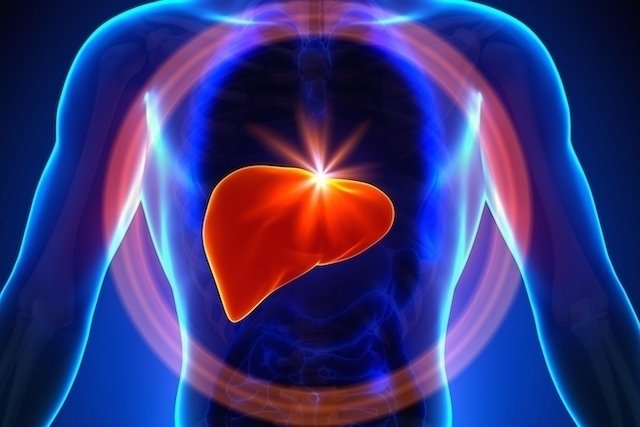Hepatitis is an inflammation of the liver caused, most of the time, by viruses, but it can also be the result of the use of medications or the body’s response, being called autoimmune hepatitis.
The different types of hepatitis are: A, B, C, D, E, F, G, autoimmune hepatitis, drug hepatitis and chronic hepatitis.
Regardless of the type of hepatitis, it is important that the diagnosis is made at the initial stage of the disease to prevent the disease from progressing and the need for a liver transplant.

Types of hepatitis
The main types of hepatitis are:
1. Hepatitis A
Main symptoms: Most of the time, hepatitis A presents mild symptoms, characterized by tiredness, weakness, decreased appetite and pain in the upper part of the belly, but fulminant hepatitis can occur. People who have already had hepatitis A have immunity to this type of hepatitis, however, they remain susceptible to other types.
How it is transmitted: Transmission of the hepatitis A virus occurs through contact with contaminated water or food. Find out how to prevent hepatitis.
What to do: It is important to practice hygiene when eating and preparing food, to avoid contact with the hepatitis A virus. It is also important to avoid sharing toothbrushes and cutlery and avoid unprotected intimate contact (without a condom).
Don’t ignore the signs your body is giving you!
2. Hepatitis B
Main symptoms: Hepatitis B can be asymptomatic, but it still requires treatment to prevent disease progression and liver deterioration. In symptomatic cases, there may be nausea, low fever, joint pain and abdominal pain. Find out what the first 4 symptoms of hepatitis B are.
How it is transmitted: Hepatitis B is transmitted through contact with contaminated blood or secretions, such as blood transfusions, sharing syringes and needles and unprotected sexual intercourse, mainly, which makes hepatitis B a Sexually Transmitted Infection (STI).
What to do: The best way to prevent hepatitis B is with vaccination while still in the maternity ward, so that the child builds immunity against this virus. If the adult did not receive the vaccine in childhood, it is important to seek a health center to receive the vaccine. It is also necessary not to have unprotected sex and pay attention to hygiene conditions when it comes to manicures, tattoos and piercings, as well as avoiding sharing syringes and needles.
3. Hepatitis C
Main symptoms: In most cases, the symptoms of hepatitis C appear between 2 months and 2 years after contact with the virus, the main ones being yellowish skin, dark urine, abdominal pain and loss of appetite. Learn about other symptoms of hepatitis C.
How it is transmitted: Hepatitis C is a liver infection caused by contact with blood or secretions contaminated with the virus and which can be cured when it is discovered early and treatment is started quickly. If left untreated, hepatitis C can progress to chronic hepatitis, which can lead to cirrhosis or liver failure.
What to do: As soon as the first symptoms of hepatitis C appear, it is recommended to go to the infectious disease specialist or hepatologist so that the diagnosis can be finalized and treatment can be started. Normally the recommended treatment is with antivirals for a period of 6 months.
4. Hepatitis D
Main symptoms: This type of hepatitis can be asymptomatic, symptomatic or severe symptomatic depending on the degree of liver involvement by the virus. Know how to identify the symptoms of hepatitis D.
How it is transmitted: Hepatitis D, also called hepatitis Delta, is an infection that can be transmitted through contact with skin and mucous membranes contaminated with the virus, through unprotected sexual intercourse or sharing needles and syringes. The hepatitis D virus depends on the hepatitis B virus to replicate and cause disease. If left untreated, it can result in fulminant hepatitis, which is a serious inflammation of the liver that can lead to death.
What to do: Prevention of hepatitis D is through vaccination against hepatitis B, as the hepatitis D virus depends on the hepatitis B virus to replicate.
5. Hepatitis E
Main symptoms: Hepatitis E is normally asymptomatic, especially in children, but when symptoms appear, the main ones are low fever, abdominal pain and dark urine. Know the symptoms of hepatitis.
How it is transmitted: Hepatitis E is transmitted through ingestion of contaminated water or food or contact with feces and urine from people contaminated with the virus. This disease often occurs in outbreaks due to poor hygiene or lack of basic sanitation.
What to do: There is no vaccine for hepatitis E and treatment consists of rest, hydration, good nutrition and avoiding taking medications or drinking alcoholic beverages.
6. Hepatitis F
Hepatitis F is considered a subgroup of hepatitis C, however the virus that causes this hepatitis has not yet been identified and, therefore, this type of hepatitis is not relevant. Hepatitis F has been verified in monkeys in the laboratory, but there are no reports of people infected with this virus.
7. Hepatitis G
How it is transmitted: Hepatitis G is caused by the hepatitis G virus, which is often found in individuals diagnosed with hepatitis B, hepatitis C or HIV. This virus can be transmitted through sex without a condom, blood transfusion or from mother to child through normal birth.
What to do: The treatment for this type of hepatitis is not yet well established, as it is not related to chronic cases of hepatitis and does not require liver transplantation, however, it is important to consult a hepatologist or infectious disease specialist for better guidance.
Watch the following video, the conversation between nutritionist Tatiana Zanin and Dr. Drauzio Varella about how to prevent and treat some types of hepatitis:
8. Autoimmune hepatitis
Main symptoms: The symptoms of autoimmune hepatitis occur due to dysregulation of the immune system, resulting in abdominal pain, yellowish skin and nausea. See how to identify autoimmune hepatitis.
As it happens: Autoimmune hepatitis is a genetic disease in which the body produces antibodies against its own liver cells, leading to their progressive destruction. On average, patients diagnosed with autoimmune hepatitis who are not properly diagnosed have a decreased survival rate.
What to do: As soon as the first symptoms appear, you should seek out a hepatologist or gastroenterologist so that the ideal treatment can be started. Typically, treatment involves the use of corticosteroids or immunosuppressants. Furthermore, it is important to maintain an adequate diet.
9. Medicated hepatitis
Main symptoms: The symptoms of medical hepatitis are the same as those of viral hepatitis, that is, vomiting, nausea, abdominal pain, dark urine and light stools, for example.
As it happens: Drug-induced hepatitis can be caused by excessive or inadequate intake of medication, the person’s hypersensitivity to the medication or toxicity of the medication. In this case, the liver is unable to metabolize the toxins from the medications and becomes inflamed, generating the typical symptoms of hepatitis. See which medications can cause medical hepatitis.
What to do: Treatment consists of stopping taking medications or switching to others that are less aggressive to the liver, always with medical advice.
10. Chronic hepatitis
Main symptoms: This type of hepatitis is characterized by fatigue, joint pain, fever, malaise, decreased appetite and memory loss.
As it happens: Chronic hepatitis is inflammation of the liver that lasts more than 6 months and can lead to cirrhosis or liver failure and, depending on the severity of the lesions, a liver transplant may be necessary.
What to do: The treatment of chronic hepatitis depends on the severity of the lesions and can be done either with the use of medications, such as corticosteroids for an indefinite period, or with a liver transplant.
How hepatitis is diagnosed
The diagnosis of hepatitis is made by a general practitioner, infectious disease specialist or hepatologist by evaluating the symptoms described by the person, in addition to the results of imaging and laboratory tests that may be requested.
Imaging tests such as abdominal ultrasound and computed tomography, for example, aim to assess the structure and integrity of the liver.
Laboratory tests are the most used to confirm hepatitis, because when there is damage or inflammation in the liver due to the presence of viruses, autoimmune diseases or chronic use of medications or alcohol, there is greater production of liver enzymes, that is, the concentration of these enzymes increase in the bloodstream, and their concentration can be used to indicate hepatitis and the stage of the disease.
In addition to evaluating the concentration of liver enzymes, to differentiate the type of hepatitis, the doctor may request serological tests to identify the presence of antigens or antibodies against a specific hepatitis virus, which can then indicate the type of hepatitis. hepatitis. Find out which tests evaluate the liver.

Sign up for our newsletter and stay up to date with exclusive news
that can transform your routine!
Warning: Undefined array key "title" in /home/storelat/public_html/wp-content/plugins/link-whisper-premium/templates/frontend/related-posts.php on line 12
Warning: Undefined array key "title_tag" in /home/storelat/public_html/wp-content/plugins/link-whisper-premium/templates/frontend/related-posts.php on line 13



